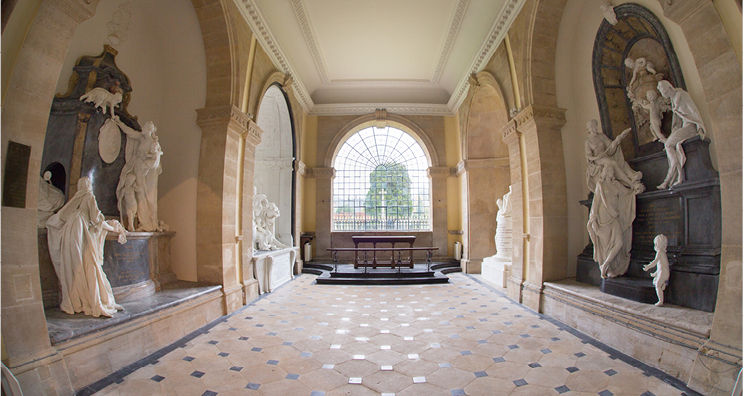About the Monuments
The Church
St Edmund’s Church, Warkton, is a beautiful parish church situated within the small estate village of Warkton, Northamptonshire. The oldest elements of the church date from the 12th century, but the current church dates largely from the 15th century. The notable exception to this is the 18th century chancel, commissioned by Mary Churchill, Duchess of Montagu and wife of John, 2nd Duke of Montagu, and designed by the celebrated French artist Louis François Roubiliac. The chancel was purposefully designed to house grand funerary monuments to the Duke and his family, and includes a huge east window which floods the space with light. The chancel and the treasures within are key reasons for the Grade I listing of St Edmund’s Church, which place it in the top 2.5% most important historic buildings in England.
The Monuments
The monuments constitute one of the finest and most important sets of funerary monuments in the country. Their importance owes to a number of factors: the skill and brilliance of the artists who created them; their significance as memorials of key figures in British history telling the story of the Montagu family over three generations; and that although each monument is a masterpiece in its own right, the combined importance of the four sculptures as a collection is an exceptional illustration to the evolution of this artistic style in Britain over nearly a century.
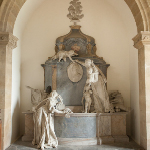 The first two monuments were sculpted by Louis François Roubiliac, one of the most eminent sculptors working in England during the eighteenth century. The first commemorates John, 2nd Duke of Montagu, who died in 1749 aged 58. It was erected by his widow, Mary Churchill, the daughter of the 1st Duke of Marlborough, who stands at the left hand side of the monument. John was the son of Ralph, 1st Duke of Montagu who was responsible for the rebuilding of Boughton House, the local family estate house. John was a military man, and his military career is symbolised in the objects surrounding his monument: a gun barrel, cannon balls, a flag, and a trumpet representing fame. The Duke was also a great benefactor, including being a forefather of the Foundling Hospital to the poor in London, which explains the figure of Charity standing to the right of the monument. John is also mourned by two children, one of whom holds a short, extinguished torch, to signify that he died relatively young.
The first two monuments were sculpted by Louis François Roubiliac, one of the most eminent sculptors working in England during the eighteenth century. The first commemorates John, 2nd Duke of Montagu, who died in 1749 aged 58. It was erected by his widow, Mary Churchill, the daughter of the 1st Duke of Marlborough, who stands at the left hand side of the monument. John was the son of Ralph, 1st Duke of Montagu who was responsible for the rebuilding of Boughton House, the local family estate house. John was a military man, and his military career is symbolised in the objects surrounding his monument: a gun barrel, cannon balls, a flag, and a trumpet representing fame. The Duke was also a great benefactor, including being a forefather of the Foundling Hospital to the poor in London, which explains the figure of Charity standing to the right of the monument. John is also mourned by two children, one of whom holds a short, extinguished torch, to signify that he died relatively young.
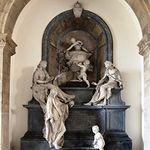 The second of Roubiliac’s monuments is commemorated to John’s wife, Mary Churchill, who died in 1751 aged 61. It was erected by her Daughter, Lady Mary Montagu. The monument is adorned with figures representing the three fates of Clotho, Atropos and Lachesis, arranged to show the cutting of Mary’s life thread, and Lachesis’ dismay at it being cut short. Three putti also figure on the monument, one of whom holds the spindle from which the thread was cut. This monument completes a spectacularly harmonious pair of exquisitely executed monuments to husband and wife.
The second of Roubiliac’s monuments is commemorated to John’s wife, Mary Churchill, who died in 1751 aged 61. It was erected by her Daughter, Lady Mary Montagu. The monument is adorned with figures representing the three fates of Clotho, Atropos and Lachesis, arranged to show the cutting of Mary’s life thread, and Lachesis’ dismay at it being cut short. Three putti also figure on the monument, one of whom holds the spindle from which the thread was cut. This monument completes a spectacularly harmonious pair of exquisitely executed monuments to husband and wife.
The third monument was sculpted by Peter Mathias van Gelder, a Dutch sculptor born in Amsterdam. The neoclassical style of the monument and the niche in which it sits show the influence of pre-eminent architect of the time, Robert Adam, with whom Van Gelder collaborated on previous commissions. It commemorates Lady Mary Montagu, daughter of Duke John and his wife, who inherited Boughton House upon their deaths. Mary married the 4th Earl of Cardigan, and later became the 3rd Duchess of Montagu. Mary was
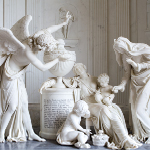 a free spirited lady who travelled extensively and independently. With her husband, she collected many of the finest paintings still in the Buccleuch Collection. Mary’s monument is more decorative that her parent’s, and is rococo in style. The composition of the monument centres around an ornate funerary urn, which stands upon a pedestal containing an inscription to Mary. To the right sits a grief stricken woman, inconsolable over the loss of an aristocrat considered a great benefactor to the poor and needy. In her left arm she cradles a baby, and a second, tearful child sits at her feet. To the right of the woman is that of an older woman draped in a shawl, who gently caresses the hand of the first babe. To the left of the urn, an angel comforts the mourners, pointing to heaven.
a free spirited lady who travelled extensively and independently. With her husband, she collected many of the finest paintings still in the Buccleuch Collection. Mary’s monument is more decorative that her parent’s, and is rococo in style. The composition of the monument centres around an ornate funerary urn, which stands upon a pedestal containing an inscription to Mary. To the right sits a grief stricken woman, inconsolable over the loss of an aristocrat considered a great benefactor to the poor and needy. In her left arm she cradles a baby, and a second, tearful child sits at her feet. To the right of the woman is that of an older woman draped in a shawl, who gently caresses the hand of the first babe. To the left of the urn, an angel comforts the mourners, pointing to heaven.
The fourth and final monument was sculpted by the Scottish designer Thomas Campbell.
It is dedicated to Lady Elizabeth, Duchess of Buccleuch, daughter of Mary of monument three, and commissioned by Walter Francis, 5th Duke of Montagu, Elizabeth’s son. It was
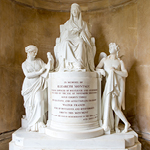 Elizabeth who brought the Montagu inheritance to the Buccleuch lineage after marrying Henry, the 3rd Duke of Buccleuch. Elizabeth was involved in a wide range of charitable work during her lifetime, and maintained a strong connection to her Christian faith, which is shown in the quotation upon her monument from the Book of Acts: “thine alms are had in remembrance in the sigh of God”. Elizabeth was also a patron of music, and was the key instigator behind the Montagu Music Collection, now held at Boughton House.
Elizabeth who brought the Montagu inheritance to the Buccleuch lineage after marrying Henry, the 3rd Duke of Buccleuch. Elizabeth was involved in a wide range of charitable work during her lifetime, and maintained a strong connection to her Christian faith, which is shown in the quotation upon her monument from the Book of Acts: “thine alms are had in remembrance in the sigh of God”. Elizabeth was also a patron of music, and was the key instigator behind the Montagu Music Collection, now held at Boughton House.
St Edmund’s remains a working village church, and visitors are warmly invited to view the monuments within on any of the advertised opening times, attend any of the regular services or just to join in the spiritual nature of this special place with a few moments of silent prayer and contemplation. For more information, please visit the church website.





